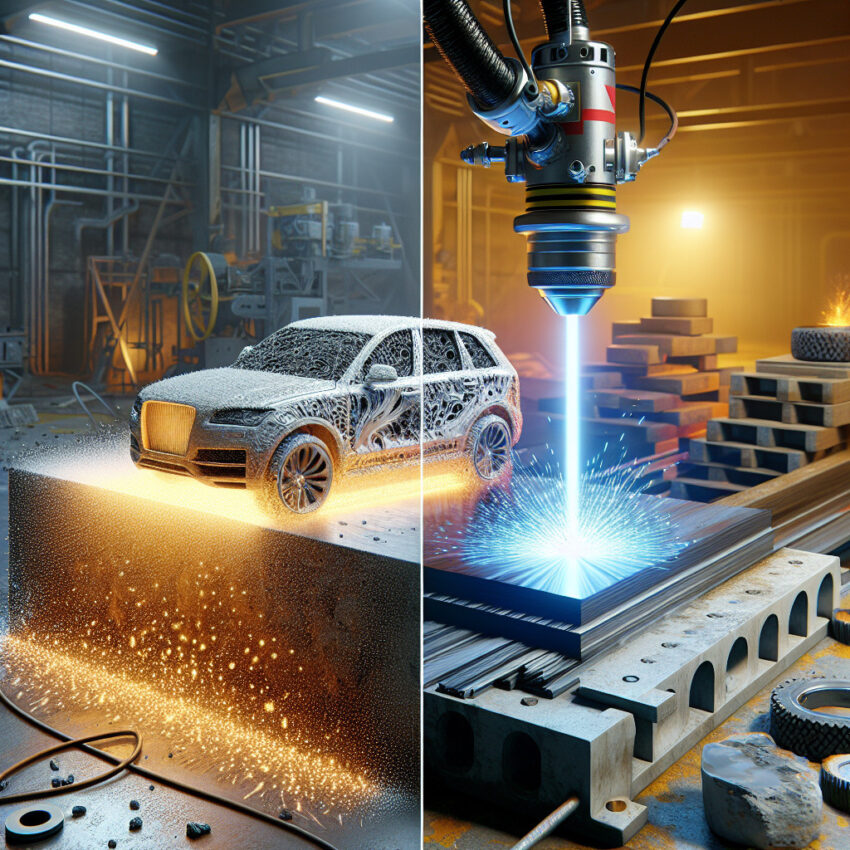- Introduction to laser cleaning technology
- Types of lasers used for paint removal
- Maintenance and upkeep of laser cleaning machines
- Effectiveness of laser cleaning on different types of paint
- Potential health hazards associated with laser cleaning for paint removal
- Advancements in laser cleaning technology for faster and more efficient paint removal
- Comparison of different laser cleaning techniques for paint removal
- Effectiveness of laser cleaning on different types of paint
Introduction to laser cleaning technology
How Does Laser Cleaning Work?
Laser cleaning works by directing a laser beam onto the surface of the material to be cleaned. The energy from the laser beam vaporizes the contaminants, leaving behind a clean surface. The process is non-contact, meaning that there is no physical contact between the laser and the material being cleaned. This makes laser cleaning ideal for delicate surfaces that could be damaged by traditional cleaning methods.
Benefits of Laser Cleaning
There are several benefits to using laser cleaning technology. Some of the key advantages include:
| Advantages | Description |
|---|---|
| Non-contact cleaning | Prevents damage to delicate surfaces |
| High precision | Allows for precise cleaning of small areas |
| Environmentally friendly | Does not require the use of chemicals or solvents |
| Cost-effective | Reduces the need for manual labor and cleaning supplies |
Applications of Laser Cleaning
Laser cleaning technology has a wide range of applications across various industries. Some common uses include:
| Industry | Application |
|---|---|
| Automotive | Removing paint and rust from car bodies |
| Aerospace | Cleaning turbine blades and engine components |
| Electronics | Removing solder and flux residues from circuit boards |
Overall, laser cleaning technology offers a fast, efficient, and environmentally friendly solution for removing contaminants from surfaces. Its versatility and precision make it a valuable tool for a wide range of industries.
#laser #cleaning #technology #industrial #applications #noncontact #precision #environmentallyfriendly #costeffective #automotive #aerospace #electronics #paintremoval #rustremoval #turbinebladecleaning #circuitboardcleaning #solderremoval #fluxresidueremoval
Types of lasers used for paint removal
2. Nd:YAG lasers: Nd:YAG lasers are another popular choice for paint removal. These lasers emit a high-energy beam of light that is absorbed by the paint, causing it to break down and flake off. Nd:YAG lasers are particularly effective at removing thick layers of paint from metal surfaces.
3. Excimer lasers: Excimer lasers are a type of ultraviolet laser that is commonly used for paint removal. These lasers emit a high-energy beam of light that is absorbed by the paint, causing it to break down and disintegrate. Excimer lasers are highly precise and are often used for delicate paint removal tasks.
4. Fiber lasers: Fiber lasers are a newer type of laser that is becoming increasingly popular for paint removal. These lasers use optical fibers to deliver a high-powered beam of light that is absorbed by the paint, causing it to vaporize. Fiber lasers are highly efficient and are capable of removing paint from a variety of surfaces.
In conclusion, there are several types of lasers that are commonly used for paint removal, each with its own unique advantages. Whether you are dealing with thick layers of paint on metal surfaces or delicate paint removal tasks, there is a laser that is suited to your needs.
Hashtags: #paintremoval #lasers #CO2 #NdYAG #Excimer #Fiber
Keywords: paint removal, lasers, CO2, Nd:YAG, Excimer, Fiber
Long-tail phrases: , advantages of using lasers for paint removal, popular types of lasers for paint removal.
Maintenance and upkeep of laser cleaning machines
In addition to keeping the machine clean, it is also important to regularly check and replace any worn or damaged parts. This includes the machine’s lenses, mirrors, and other optical components, as well as any seals or gaskets that may be worn out. Regularly inspecting these parts can help prevent costly breakdowns and ensure that the machine continues to operate smoothly.
Another important aspect of maintenance for laser cleaning machines is calibrating the machine’s settings. Over time, the machine’s settings may drift out of alignment, reducing its effectiveness. Regularly calibrating the machine can help ensure that it is operating at peak performance and remove any inconsistencies in the cleaning process.
In addition to these regular maintenance tasks, it is also important to follow the manufacturer’s recommended maintenance schedule for the machine. This may include regular inspections, cleanings, and calibrations, as well as any other specific tasks that are necessary to keep the machine in good working order.
By following these maintenance tips, you can help ensure that your laser cleaning machine continues to operate at peak performance and provide you with the best possible results. Remember, regular maintenance is key to keeping your machine running smoothly and efficiently.
#laser #cleaning #machine #maintenance #upkeep #optics #calibration #manufacturer #schedule
Keywords: laser cleaning machine, maintenance, upkeep, optics, calibration, manufacturer, schedule
Long-tail phrases: importance of maintenance for laser cleaning machines, tips for keeping laser cleaning machines in good working order, regular maintenance tasks for laser cleaning machines, benefits of following manufacturer’s recommended maintenance schedule for laser cleaning machines.
Effectiveness of laser cleaning on different types of paint
Types of paint
There are several types of paint commonly used on surfaces, including acrylic, enamel, latex, and oil-based paints. Each type of paint has its own unique properties, such as thickness, adhesion, and chemical composition, which can affect how easily it can be removed using laser cleaning.
Effectiveness of laser cleaning
Research has shown that laser cleaning is highly effective in removing paint from surfaces, regardless of the type of paint used. The laser beam is able to target the paint layer specifically, without damaging the underlying surface. This makes laser cleaning a preferred method for paint removal, especially in cases where traditional methods such as sandblasting or chemical stripping may cause damage to the surface.
Factors influencing effectiveness
Several factors can influence the effectiveness of laser cleaning on different types of paint. These include the power and wavelength of the laser, the speed at which the laser beam is moved across the surface, and the type of paint being removed. In general, higher power lasers are more effective at removing paint quickly, while shorter wavelengths are better suited for removing thin layers of paint.
Conclusion
In conclusion, laser cleaning is a highly effective method for removing paint from different types of surfaces. Its precision and efficiency make it a preferred choice for paint removal, especially in cases where traditional methods may cause damage to the surface. By understanding the factors that influence the effectiveness of laser cleaning, users can achieve optimal results when using this technology.
- paint removal
- laser cleaning
- surface contaminants
- efficiency
- precision
- high power lasers
- short wavelengths
- chemical composition
- adhesion
- thickness
#paintremoval, #lasercleaning, #surfacecontaminants, #efficiency, #precision
Potential health hazards associated with laser cleaning for paint removal
1. Eye Damage
One of the most significant risks of laser cleaning is eye damage. The intense light produced by the laser can cause permanent damage to the eyes if proper safety precautions are not taken. Workers must wear appropriate eye protection, such as laser safety goggles, to prevent injury.
2. Skin Burns
Another potential health hazard of laser cleaning is skin burns. The high temperatures generated by the laser can cause burns if the skin comes into contact with the beam. Workers should wear protective clothing, such as gloves and long sleeves, to minimize the risk of skin burns.
3. Inhalation of Fumes
During the paint removal process, fumes and particles may be released into the air. Inhaling these fumes can be harmful to respiratory health, causing symptoms such as coughing, shortness of breath, and chest tightness. Workers should wear respiratory protection, such as masks or respirators, to reduce the risk of inhalation exposure.
4. Fire Hazard
Laser cleaning can create sparks and heat, increasing the risk of fire. It is essential to remove any flammable materials from the work area and have fire extinguishing equipment readily available. Proper training in fire safety procedures is also crucial to prevent accidents.
5. Electrical Hazards
Laser cleaning equipment operates on electricity, posing a risk of electrical shock if not handled correctly. Workers should be trained in electrical safety practices and ensure that the equipment is properly grounded to prevent accidents.
| Health Hazard | Precautions |
|---|---|
| Eye Damage | Wear laser safety goggles |
| Skin Burns | Wear protective clothing |
| Inhalation of Fumes | Use respiratory protection |
| Fire Hazard | Remove flammable materials, have fire extinguisher |
| Electrical Hazards | Ensure proper grounding, follow electrical safety practices |
In conclusion, while laser cleaning offers many benefits for paint removal, it is essential to be aware of the potential health hazards associated with this technology. By following proper safety precautions and training, workers can minimize the risks and ensure a safe working environment.
#healthhazards #laser cleaning #paintremoval #safety precautions #eye protection #skin burns #respiratory health #fire hazard #electrical safety #workplace safety #occupational health and safety #protective equipment #safety training #fire safety procedures #electrical shock #grounding #respiratory protection #inhalation exposure #workplace hazards #safety guidelines.
Advancements in laser cleaning technology for faster and more efficient paint removal
Another important advancement is the integration of automation and robotics into laser cleaning systems. This allows for greater control and consistency in the paint removal process, as well as increased efficiency and productivity. Automated laser cleaning systems can be programmed to follow specific patterns or paths, ensuring thorough and uniform paint removal.
Furthermore, advancements in laser technology have led to the development of more compact and portable laser cleaning systems. This makes them easier to transport and use in a variety of settings, from automotive workshops to industrial manufacturing facilities.
In addition to being faster and more efficient, laser cleaning technology is also more environmentally friendly than traditional paint removal methods. Laser cleaning produces minimal waste and does not require the use of harmful chemicals or solvents. This makes it a more sustainable and eco-friendly option for paint removal.
In conclusion, advancements in laser cleaning technology have revolutionized the paint removal process, making it faster, more efficient, and environmentally friendly. With the development of more powerful lasers, automation and robotics integration, and compact portable systems, laser cleaning is poised to become the preferred method for paint removal in a wide range of industries.
| Advancements | Benefits |
|---|---|
| More powerful lasers | Quick and effective paint removal |
| Automation and robotics integration | Greater control and consistency |
| Compact and portable systems | Easy to transport and use in various settings |
#laser #cleaning #technology #paint #removal
Keywords: laser cleaning, paint removal, advancements, efficiency, automation, robotics, environmental friendly
Long-tail phrases: advancements in laser cleaning technology, faster paint removal, more efficient paint removal, environmentally friendly paint removal.
Comparison of different laser cleaning techniques for paint removal
– Uses a high-energy laser beam to vaporize the paint layer.
– Fast and efficient, but can damage the underlying surface if not used properly.
– Suitable for removing thick paint layers.
2. Laser-induced breakdown spectroscopy (LIBS):
– Uses a laser beam to create a plasma on the surface, which is then analyzed to determine the composition of the paint.
– Can be used to identify different types of paint for selective removal.
– Not suitable for large-scale paint removal due to its slow speed.
3. Laser-induced thermal imaging (LITI):
– Uses a laser beam to heat the paint layer, causing it to expand and crack.
– Effective for removing thin paint layers without damaging the underlying surface.
– Can be used for delicate surfaces that are sensitive to high-energy lasers.
4. Laser-induced shockwave cleaning (LISC):
– Uses a high-energy laser pulse to create a shockwave that removes the paint layer.
– Fast and efficient, but can cause surface damage if not controlled properly.
– Suitable for removing thick paint layers on metal surfaces.
In conclusion, each laser cleaning technique has its own strengths and weaknesses, and the best choice will depend on the specific requirements of the paint removal task. Laser ablation is fast and efficient but can be damaging to the surface, while LIBS is useful for identifying paint types but is slow. LITI is effective for delicate surfaces, and LISC is suitable for thick paint layers on metal surfaces.
#laser #paintremoval #cleaningtechniques #comparison #industrialapplications
Keywords: laser cleaning, paint removal, laser ablation, LIBS, LITI, LISC, surface cleaning, industrial applications
Long-tail phrases: comparison of laser cleaning techniques for paint removal, advantages and limitations of laser ablation, laser-induced breakdown spectroscopy for selective paint removal, laser-induced thermal imaging for delicate surfaces, laser-induced shockwave cleaning for metal surfaces.
Effectiveness of laser cleaning on different types of paint
Types of paint
There are several types of paint that are commonly used on surfaces, including acrylic, enamel, latex, and oil-based paints. Each type of paint has its own unique properties, such as thickness, adhesion, and chemical composition, which can affect how easily it can be removed using laser cleaning.
Effectiveness of laser cleaning
Research has shown that laser cleaning can be highly effective in removing paint from surfaces, particularly when compared to traditional methods such as sandblasting or chemical stripping. Laser cleaning is able to target the paint layer specifically, without damaging the underlying surface, resulting in a cleaner and more precise finish.
Factors influencing effectiveness
There are several factors that can influence the effectiveness of laser cleaning on different types of paint. These include the type of paint being removed, the power and wavelength of the laser, the speed and angle of the laser beam, and the distance between the laser and the surface. Additionally, the condition of the surface and any underlying layers of paint or coatings can also impact the success of the cleaning process.
Conclusion
In conclusion, laser cleaning is a highly effective method for removing paint from different types of surfaces. By understanding the properties of the paint being removed and adjusting the parameters of the laser accordingly, it is possible to achieve a clean and precise finish without damaging the underlying surface. Further research is needed to explore the full potential of laser cleaning in the field of surface preparation and restoration.
- paint removal
- laser cleaning
- surface preparation
- precision cleaning
- effectiveness of laser cleaning on different types of paint
- factors influencing the success of laser cleaning
- research on laser cleaning technology
#paintremoval #lasercleaning #surfacepreparation #precisioncleaning
#effectivenessoflasercleaningondifferenttypesofpaint #factorsinfluencingthesuccessoflasercleaning #researchonlasercleaningtechnology
- Laser cleaning for removing mold and mildew from surfaces - 24 July 2024
- Laser cleaning for removing paint from surfaces - 14 April 2024
- Jakie są trendy na rynku najmu mieszkań w Warszawie? - 23 October 2023




